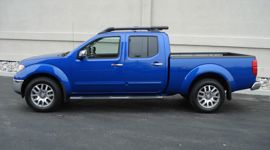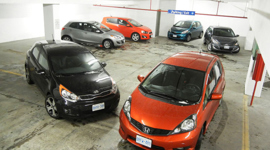Vehicle Type
Funny wagon-box thingy
History/Description
From 2009, Nissan brought the Japanese-market cube over to our shores, hoping to appeal to shoppers after a vehicle that combined heaps of space, good fuel efficiency, compact driving manners and a full suite of options and features for customization. The tall and boxy five-door model was marketed not as a car, but as a so-called mobile device, with Nissan hesitating to put the cube (intentionally un-capitalized, since it’s such an individual!) into a vehicle category.
Practicality, better-than-you’d-think performance and driving manners, maneuverability, outward visibility and an all-around fun-to-drive, ready-for-anything sort of package
So, look for the recently-discontinued model to offer manual or CVT transmissions, a standard 1.8L engine with 122 horsepower, a full suite of standard safety systems, and room galore on board, especially where headroom was concerned.
Available feature content included automatic climate control, Bluetooth, a leather-wrapped steering wheel, a punchy Rockford Fosgate stereo system, and a full range of over 40 individual accessory options, including a curious pad of shag carpet that could be fixed to the dash to hold items in place with its fuzziness. Push-button start with intelligent key, and interior mood lighting were also available.
Shoppers should note that model grades included the cube 1.8, 1.8S and 1.8 SL, from basic to loaded where equipment was concerned. The cube Krom model was a styling package which added exclusive grille treatments, unique wheels, a spoiler, and some upscale feature content.
What Owners Like
Nissan cube owners tend to rave about practicality, better-than-you’d-think performance and driving manners, maneuverability, outward visibility and an all-around fun-to-drive, ready-for-anything sort of package. Gas mileage, a slick-shifting six-speed stick and heaps of interior space, headroom and legroom all round out the appeal. Noise levels are kept nicely in check too. All said, the owners’ community suggests that the cube is surprisingly nice to drive, despite its odd shape suggesting it might be noisy, tippy and slow.
What Owners Dislike
Common gripe points include plasticky and low-budget interior bits, and a tendency for the cube to drive like a sort of four-wheeled kite on the highway when strong wind catches it.
Here’s a look some owner reviews.
Common Issues
Start your walk-around of a potential used cube candidate with some common checks. Is there rust under the edges of the door or hatch? At the edge of the hood? Do the tires look new and fresh, or aged and worn? Is there any sign of excessive wear around the cargo area, door sills or paint? Confirm proper operation of the rear door latch, several times, ensuring it opens via both the key and the remote release (if equipped). Problems with the rear door latch and lock seem fairly rare, but have been documented. The issue may stem from a bad lock actuator. Be sure to keep your cube’s locks and latches lubricated with a little blast of lithium grease to prevent corrosion to the mechanical bits, and wiring. The same issue may affect other doors, too, so be sure to check them all.
Some owners have also reported issues with the fuel door latch mechanism, where a piece snaps off and causes damage. Apparently this isn’t a hard fix for a do-it-yourself type, and requires removal of the wheelwell to access the part.
Here’s a DIY post relating to repair of the cube’s potentially-troublesome steering-lock mechanism, which may fail and render the cube undriveable as the wheel will be locked in place and engine start-up may not be possible. This issue will be fairly apparent on a test-drive: if you can’t turn the wheel, or the key, a bad steering lock is to blame. The DIY fix is welcome to many owners, as the cost to repair this part out of warranty looks fairly prohibitive.
On board, inspect all electronics for proper operation. Confirm that no Check Engine lights are present. Though these lights may appear for numerous reasons, some owners have reported the presence of the P0101 code, which references a bad Mass Air Flow sensor. In some cases, cleaning or replacement of the sensor fixes the issue (it’s a pricey piece, so try cleaning first). In other cases, the sensor is fine, and updated computer software to the ECU is the fix. Ask your local dealer for more information if a pre-purchase electronics scan reveals this code.
Inspect the outboard driver’s seat bolster for signs of wear or ripping. If the cube you’re considering shows excessive amounts of wear relative to its age or mileage, call it into pricing negotiations.
When driving, note that performance issues that include lugging or bogging under light or moderate acceleration could be caused by a bad knock sensor, which may or may not be accompanied by a check engine light. The cube should travel straight down a flat, even road surface if the steering-wheel is released momentarily. Any pull to the side, or failure to track straight down the road, could indicate an issue with alignment.
Spend a few minutes in the cargo area, pulling up carpeting and paneling to search for signs of moisture and water leaks. Staining, a gross mildewy smell, or actual damp carpets are good signs that the rear hatch weather seals could be leaking. One cause is a buildup of dirt and road crud around the plump rubber seals, which prevent a flush seal and allow water through. Some owners have included cleaning of the weather seals in their annual maintenance to help fend off leaks. Ensure all weather seal segments are intact, plump, and free of damage and cracking.
Once the model you’re test-driving is warmed up to operating temperature, turn the stereo system and climate control off and lock your ears onto the CVT transmission (if equipped), as the vehicle comes to rest when stopped. Some owners have reported a rattling noise, which could be the result of a loose or improperly-installed powertrain mount. This should be an easy fix for a Nissan mechanic if present.
Remember that frequent, high-quality oil changes are a fantastic defense against engine wear and problems on any used ride.
The Continually Variable Transmission (CVT), though present in numerous Nissan products for years, is a questionable piece of hardware in the eyes of some used shoppers not familiar with it. Like virtually any transmission, the CVT has maintenance requirements – mainly in the form of fluid changes – that are vital to its long-term reliability and durability.
The CVT unit used in the cube looks relatively free of systematic issue, though some owners have reported issues and replacement under warranty. Possible indicators of CVT trouble may include rattling sounds, difficulty switching between reverse and drive (or vice versa), and sporadic behavior in terms of revving and ‘shifting’.
Shoppers concerned with the CVT can have a Nissan mechanic test-drive the vehicle they’re considering as part of a pre-purchase inspection, or simply opt for a unit with the manual.
Here’s a discussion amongst owners happy with their Nissan CVT transmission, and another discussion amongst some owners who aren’t. Apparently, filling the CVT with non-specified fluids can be troublesome, so be sure the cube you’re considering has only ever had its transmission serviced at the dealer.
The Verdict
Seems like cube’s proven engine should be largely free of issue, with other likely problems appearing easy to identify and fix. Research shows a car largely loved by a strong owners’ community, with many repairs being simple for do-it-yourself types. A full pre-purchase inspection at a Nissan dealer is advised ahead of your purchase, and a clean bill of health and a fair price on a used cube should put you well on your way to ownership of vehicle loved for efficient and funky-looking access to heaps of space.
Here’s a list of recalls.
Crash Test Ratings
IIHS: Top Safety Pick (2013)
NHTSA: NA


































